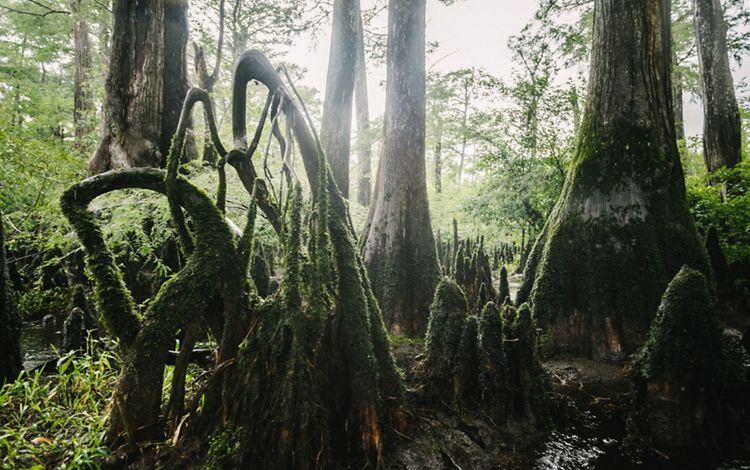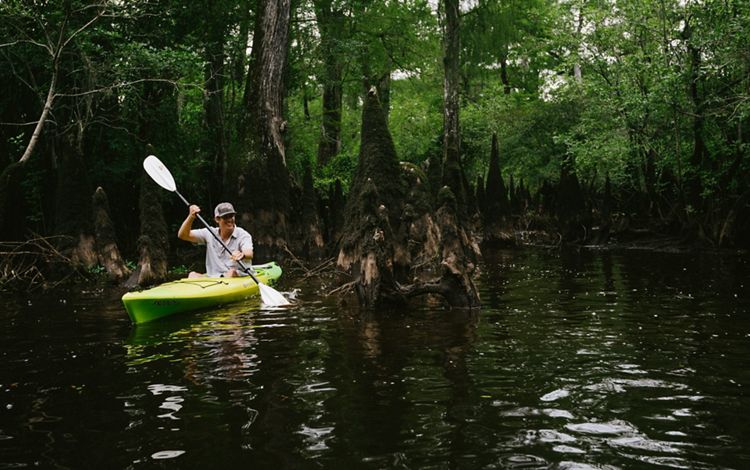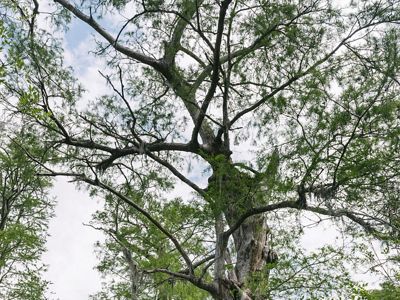.jpg?crop=0%2C0%2C1637%2C1228&wid=640&hei=480&scl=2.558333333333333)
North Carolina has lots of superlatives.
Being home to the tallest mountain east of the Rockies (Mount Mitchell) and the tallest sand dune system on the East Coast (Jockey's Ridge) are often the first that come to mind. Many are not aware that the Old North State boasts another natural history record of a similar degree. North Carolina is home to the oldest trees in eastern North America—the bald cypress on the Black River.
The ancient trees were discovered by accident in the 1980s. University of Arkansas professor David Stahle was exploring the relationship between tree growth rings and climate. His work led him to the Black River in southeast North Carolina.
Using an increment borer, essentially a hollow tube that takes a small cross section of a tree without harming it, he counted growth rings of Black River bald cypress. Many of the trees are more than 500 years old. The oldest identified tree, scientifically labeled BLK69 and locally known as Methuselah, dates back to 364 AD. Stahle suspects other trees in the area are older, though core rot prevents his team from determining their exact age. The Nature Conservancy protected and manages the Three Sisters swamp where these ancient giants grow.
The Black River, which flows through Sampson, Pender and Bladen counties before emptying in the Cape Fear, lies in a part of North Carolina that has seen substantial changes in the past decades. Agricultural operations like row crops and hog and poultry farms compromise most of the watershed. Timber harvesting of cypress and other floodplain trees is a threat to these ancient stands.
The Nature Conservancy is the sole conservation group actively working to protect these ancient trees. Since the 1990s, we’ve protected over 16,000 acres of land in the Black River basin. The bald cypress aren’t the only reason for that.
The ancient trees are part of a forest that buffers the Black River, limiting nutrients and other pollutants from flowing into the river. They do a great job of it. The Black River has an Outstanding Resource Water designation, which is the state’s highest water classification.
Good water quality is important for people and for nature. The Black River provides habitat to several rare and endangered species. Atlantic sturgeon and shortnose sturgeon come up river from the Atlantic to reproduce, several rare mussels live in its waters, and the ancient cypress are home to the threatened northern long-eared bat.
.jpg?crop=0%2C38%2C1920%2C1203&wid=750&hei=470&scl=2.56)



Trip Planner
The river makes for an incredible paddle trip. Keep in mind that water levels fluctuate significantly during the year. You may have to maneuver and/or portage around fallen logs and trees during dry periods.
Following the Pender County / Bladen County line, the Black River is easy to see on a map. Some of the old-growth bald cypress can be seen from the NC 53 bridge 4 miles south of Atkinson.
Several put-ins and boat landings provide access to scenic parts of the river:
- The NC Wildlife Resources Commission has two public boat landings on the river: one is located approximately 5 miles north of Beatty's Bridge on Ivanhoe Road (SR 1550 in Bladen County and SR 1201 in Pender County) and the other is located 1.2 miles east of the 11/53 bridge off Long View Road (SR 1547).
- You can access the river fairly easily from either side of Beatty's Bridge. There is a sandy bank under the bridge that provides good canoe access.
- You can access the river by canoe from the NC 11/53 Bridge located just outside Atkinson.
Here are a few options for a daylong boat trip on the Black River:
- Put in at the Wildlife Resources Commission public landing approximately 5 miles north of Beatty's Bridge on Ivanhoe Road and take out at Beatty's Bridge. This stretch is about 9 river miles and passes through some bottomland hardwood areas as well as cypress swamp. You can park a car on the side of the road at Beatty's Bridge.
- If you are ambitious, you could put in early in the morning at Beatty's Bridge and canoe about 14 miles to another Wildlife Commission public board landing that is about 1.5 miles south of the 11/53 bridge just outside of Atkinson off NC 3. This stretch of the river contains Larkin's Cove and Three Sisters, sites where the oldest known stands of bald cypress have been found.
- Another option is to park and put in at the second Wildlife Resources Commission landings and canoe upstream toward Three Sisters. This is a nice area because it contains several coves with ancient cypress.
